Miers, William (McKechnie Section 2)
See also Section Five and entries on John Miers in Section Four, and on William Miers and Field in Sections Four and Five
William Miers, profilist, frame-maker and engraver on metal and seals, was the son of John Miers, one of the best-known of silhouette artists. Some information, especially about his place in the history of the Miers family, is given in the entry on his father, cited above. The entries on William Miers and Field concern his partnership with John Field. In the present entry we are concerned (apart from the known facts of his life) with the few profiles painted on paper which emanated from his studio (though he probably did not paint them himself) and with his work as frame-maker and engraver.
We know, from records in the Guildhall Library, London, that William Miers was born on 27 June 1793, this date of birth being 'registered' with the dates of birth of two younger sisters at the London Wall Chapel, a Presbyterian church. This date is confirmed by the entry on the 1851 census form, which gives his age as fifty-seven. (We also know from this form that Amelia Miers, his wife, was three years his senior). His birth-place was almost certainly 111 Strand, London, his parents' home, his father's studio and, in due course, his own place of work.
The later trade labels of John Miers indicate that, before his father's death on 2 June 1821, William had established a frame manufactory at 111 Strand. During the years 1823-29 he worked in partnership with John Field at the same premises (see Sections Four and Five). From late 1829, as we know from Trade Label No. 1, he worked (on his own) as an engraver also, and described himself as 'profilist'. A series of directory entries indicate his occupation and addresses in London from 1829 until 1861, two years before his death:
1829 111 Strand Miers and Field
1830 111 Strand Miers, William
1831 111 Strand Miers and Field (from an obviously out-of-date directory)
1832 111 Strand Miers, William, Profilist
1835-37 111 Strand Miers. William, Profilist and Miniature Frame-Maker
1838-40 111 Strand Miers, William, Miniature Frame-maker and Naturalist
1842 31 Cockspur Street Miers, William, Miniature Frame-maker
1844 36 Haymarket Miers, William, Miniature Frame-maker
1846 8 Greek Street As above
1850 35 Princes Street As above
1853 5 Charlotte Street As above
1854 94 Dean Street, Soho As above 1856-61 88 Dean Street, Soho As above
William and Amelia Miers had two sons, William Thomas and John Samuel. The former, although he started a career as an electrotypist, was, by 1847, in his grandfather's native city, Leeds, pursuing his grandfather's early occupation as an oil and colour merchant. His younger brother joined him in this business, and the two married sisters bore ten children apiece.
Although the directory entries for 1832-37 describe Miers as 'profilist', the few profiles seen backed with the trade label which he used at the time incline me to think that he did not take them himself, but employed a profilist to make copies from his collection of duplicates of silhouettes by his father (some of which dated from as far back as 1781) or John Field, as orders were received, and occasionally to paint a few profiles from life. In what respect Miers was a 'naturalist' is uncertain. Perhaps this directory entry simply means 'one versed in natural history'. For the last twenty years of his life Miers evidently continued to work in metal as a frame-maker, but a trade card (illustrated) used in 1850 in Princes Street (Leicester Square, London) tells us that at this date he was a copper-plate and seal engraver, as well as a manufacturer of ormolu miniature frames, morocco cases, mats and glasses. This card tells us that Miers still had a factory.
896
Miers died on 22 August 1863, aged seventy. No will or letters of administration of William Miers are at Somerset House, and he may have died intestate.
Most of Miers's activities are set out on the trade labels discussed below. On Trade Label No. 1 he is represented primarily as a goldsmith and engraver, although silhouettes, the copying of miniatures, and frame-making are also offered. According to Trade Label No. 5, by 1850 he was working chiefly as a plate-and seal-engraver. Apart from these crafts he worked for many years as a specialist frame-maker, particularly in ormulu, and this appears to have been his chief occupation. I will consider Miers's work in the two categories of silhouettes and frame-making in turn, followed by a brief note on him as engraver.
In this Section we are concerned with a few profiles painted on paper, backed with Trade Label No. 1. Though all of these were produced by William Miers's studio, none, I believe, were his work. One, of Philip Cornish (illustrated), is obviously a copy from a duplicate, the original of which was taken at 111 Strand during the early 1790s (see John Miers, Section Four, 'X' work). The silhouette of Mr W. Smith (illustrated) is also a copy (from an example painted on plaster by John Field in c. 1805. The copy is dated October 1831 on the back, but the sitter's clothes are those of c. 1805). Mr Graham Thomas has given me details of a third example. This, a bronzed silhouette on card of the Reverend J. Babington, dated January 1833, is rectangular in shape and framed in a red morocco leather case. It bears on the back the 'Miers and Field' jewellery trade label (see the entry on them in Section Five), with Field's name erased. This is the type of work which, during the period while Field was working at 111 Strand, would have been painted on ivory; it appears, therefore, that whoever painted it, lacking proficiency as a painter on ivory, used card instead.
A fourth example, competently painted in black water-colour against a grey background, was sold by Sotheby and Company, London, in 1971. This was painted from life, but in the style to be expected from Charles Hervé. Now Hervé was an expert copyist who also painted silhouettes skilfully in his own style (see the illustration in this Section of his copy of a silhouette painted at the studio of John Miers).
834
Until c. 1830 Hervé was occupied with the Prosopographus gallery (see Section One), and I have seen no work bearing his own name dating from before c. 1835. It seems likely that it was he who was employed by William Miers for a few years, either to make copies from the duplicates (which he could faithfully reproduce) or to paint silhouettes from life in his own style.
The earliest evidence that frames for miniatures (probably made by William Miers) were offered for sale at 111 Strand is provided by Trade Label No. 12 (the 'Double-letter' label) of John Miers (q.v., Section Four), known to have been used as early as 25 July 1810. This label was normally used for bronzed work by John Field, in papier mâché frames with ormulu leaf hangers and 'matting' ormulu ovals. In 1810 William Miers was seventeen, and it does seem likely that it was with the making of such frames that he began his specialist ormulu work. Such frames continued to be sold by the Miers and Field partnership, but the labels used by William Miers as a frame-maker have also been seen on the far more elaborate ormulu frames that housed portrait miniatures. Rectangular, with the corners adorned with shells, these frames had ormulu surrounds and central brass ovals round the portrait. William Miers excelled in the making of such frames. The silhouettes painted on ivory for rectangular pocket-cases, produced at 111 Strand, also have elaborate chased or engraved ormulu surrounds, and these were probably made by William Miers. This ormulu work was moulded, but the original cast was, of course, carved.
893
If a trade label of William Miers is seen on a papier mâché frame it does not necessarily indicate that he was responsible for the papier mâché part of the frame; he is more likely to have made the metal parts only. No doubt he also made oval frames for portrait miniatures. Trade Label No. 4 mentions the exporting of frames; the illustrated example was in fact seen on the back of a papier mâché frame which was sent to Britain from the United States for sale by auction. Since this bears the 111 Strand address, it must have been made before 1840. Miers probably also made larger ormulu surrounds for rectangular frames intended to house larger pictures.
It seems that William Miers specialized in work of this nature from c. 1810 until a year or two before he died. One profile by Thomas Lovell (see Section Four) is in an original frame with ormulu 'matting' surround. Lovell died in 1806. If William Miers was responsible for the ormulu furniture on this particular example, he may have begun work of this kind at the early age of twelve or thirteen. It is possible, however, that this design was originally by an unknown frame-maker, and was later adopted as a standard design by Miers.
1280
It is probable that William Miers was the seal-engraver mentioned on the later labels used at 111 Strand during the period 1821 until 1823. The trade labels used by William Miers himself include the terms 'engraver' and 'copper-plate and seal-engraver' as late as 1850, and it is likely that he practised this craft throughout most of his career.
The trade labels and cards discussed below include only those used by William Miers after the dissolution of his partnership with John Field towards the end of 1829.
894-896
Those used by Miers and Field in partnership are discussed in the entry on them in Section Four. I have suggested in the entry on John Miers in Section Four that the name Miers at the head of Trade Labels 13 and 14, used at 111 Strand after John Miers's death, in fact referred to William Miers. Small printings of these two labels were probably ordered while discussions about a partnership between William Miers and Field were still in progress. Of those which are discussed below only Nos 1 and 2 are likely to be seen on the few silhouettes painted for William Miers during the early 1830s. The remainder are the labels which he used as frame-maker.
Trade Label No. 1 has been seen on the reverse of the frame containing two bronzed profiles on ivory (see Section Five), and on the reverse of others painted on paper. It was probably used from late 1829 until c. 1834. Beneath the coat-of-arms it reads:
GOLDSMITH MIERS ENGRAVER
MINIATURE FRAME MAKER PROFILIST &C. by APPOINTMENT TO THE QUEEN NO. 111, STRAND Eleven doors west of Waterloo Bridge.
Mourning orders executed.
MINIATURES CORRECTLY COPIED
Miniature Profiles for Bracelets, Brooches, Rings etc. as accurately as the Larger sizes.
Time of Sitting FIVE MINUTES. W. Miers has preserved all the original profiles for nearly half a century, and can supply COPIES of every size WITHOUT THE NECESSITY OF SITTING AGAIN.
An extensive stock of ORMULU MINIATURE FRAMES, &C, are kept, which being really Manufactured on the premises. Artists may rely on the greatest punctuality in die execution of Orders.
The address at 111 Strand is described as 'eleven doors west of Waterloo Bridge', not as 'opposite Exeter Exchange', since the Exchange was demolished in 1829.
Trade Label No. 2, used either on copies of silhouettes or silhouettes of jewellery size taken from life during the years when Miers advertised as a profilist, appears to be the label used earlier by the Miers and Field partnership, but with Field's name obliterated.
Three labels, used by Miers as a frame-maker only, have come to light. The first of these (Trade Label No. 3, used before 1840), seen on the backs of well cast ormulu frames, complete with tooled ormulu sheets bearing an oval in the centre for the miniature, is illustrated.
The second (Trade Label No. 4) mentions that frames are exported if this is required. An example has been seen on the back of a miniature (late 1830s) in a papier mâché frame, sent from the United States to Britain for sale by auction.
Trade Label No. 5 is a trade card used at 35 Princes Street c. 1850-53. It mentions a factory in which miniature frames and morocco cases are made, as, well as a Royal Appointment to Queen Victoria as a frame-maker. The design is the same as that adopted for Trade Label No. 1 twenty years earlier at 111 Strand.
Ills. 28, 38. 75. 889-896
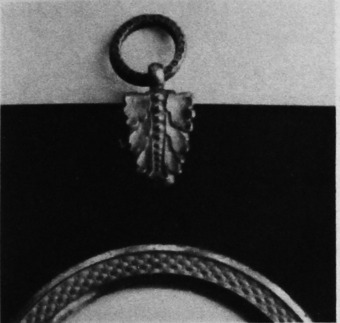
Leaf design in ormulu; part of the matting ornamentation round the oval surrounding the silhouette is also shown. Note also the ornamented ring. Probably the work of William Miers.
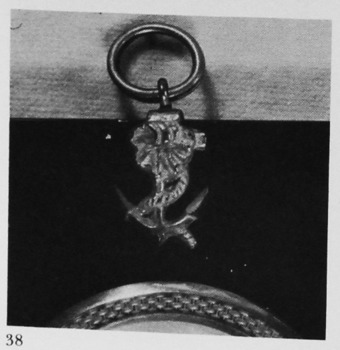
Rope shell, and anchor design for a silhouette representing an admiral.
Probably made by William Miers.
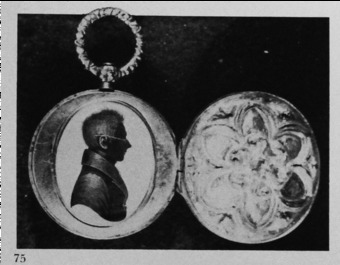
Silhouette, almost certainly by John Field, painted on ivory inside the case of a gold fausse montre, 1820s.
The ormulu surround may have been made by William Miers. Diameter of watch: 1in./26mm.
M. A. H. Christie collection
SECTION TWO
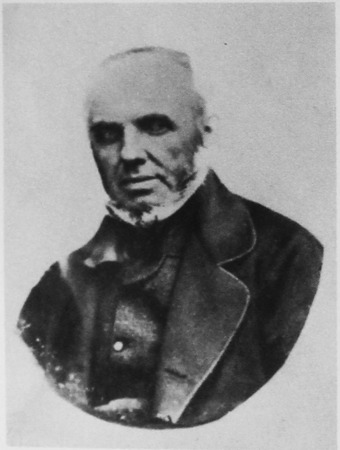
William Miers
Photograph taken from a daguerrotype taken probably c. 1855-60.
Author’s collection: presented by a descendant of the artist
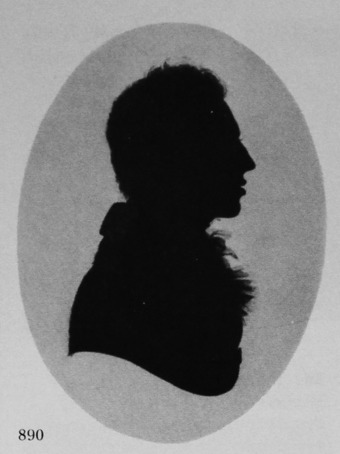
William Miers
Silhouette painted on card by John Field, c. 1816.
From L. Morgan May, ‘A Master of Silhouette’ (Martin Secker 1938), by courtesy of Mrs B. Morgan May
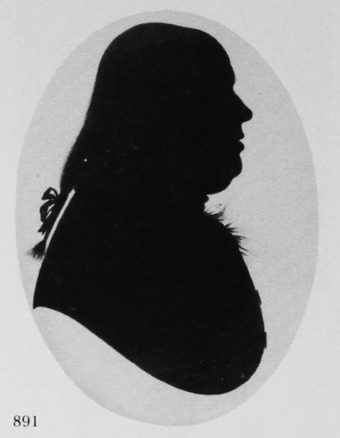
Philip Cornish
Silhouette painted on card, copy of a silhouette taken at the studio
Date of original silhouette: early 1790s
3½ x 2 3/8 in./90 x 61mm.
Trade Label No. 1
Frame: oval, turned wood
The sitter, a surgeon, lived in Wiltshire; he was born in 1757 and died in 1823. The frame was probably made from old stock at the studio.
T. E. F. Sainsbury collection
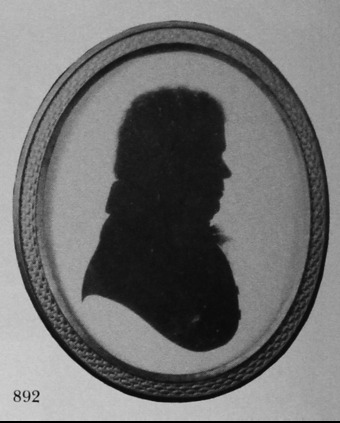
W. Smith
Silhouette painted on card, copy of an original silhouette by John Field
Date of copy: October 1831
3¼ x 2 5/8 in./83 x 67mm.
Trade Label No. 1
Frame: papier mâché, with ormolu furniture.
M. A. H. Christie collection
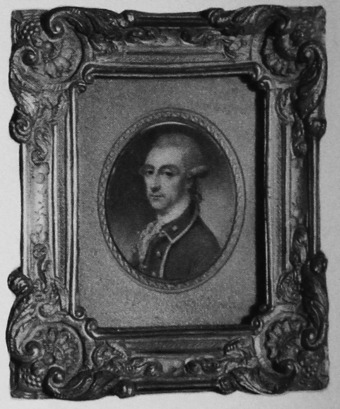
Portrait miniature set in an ormolu frame made by William Miers, bearing Trade Label No. 3.
Private collection
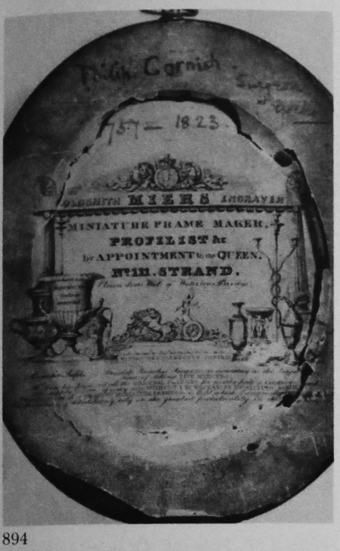
Trade Label No. 1 of William Miers (used for silhouettes), from the silhouette in 891.
T. E. F. Sainsbury collection
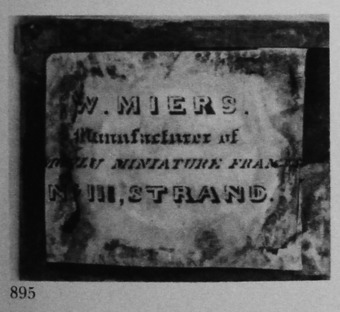
Trade Label No. 3 of William Miers (used by him as frame-maker), from the frame shown in 893.
Private collection
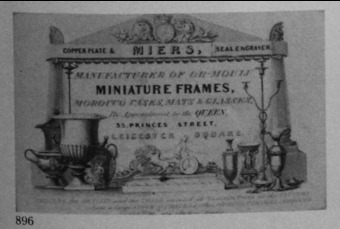
Trade Label No. 5 of William Miers (used by him as frame-maker).
Author’s collection
